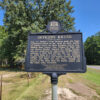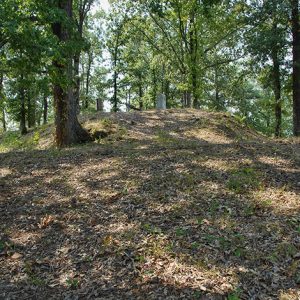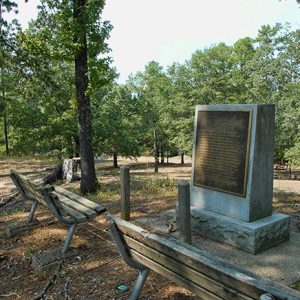calsfoundation@cals.org
Forts Lookout and Southerland
aka: Forts Southerland and Lookout
aka: Fort Diamond
Forts Lookout and Southerland are large earthen redoubts constructed in early 1864 to defend Camden (Ouachita County) from Federal attack during the Civil War. The forts were listed on the National Register of Historic Places on April 19, 1994, and designated as National Historic Landmarks on the same date as components of the Camden Expedition National Historic Landmark.
In late 1863, following the September 10 capture of Little Rock (Pulaski County), Lieutenant General Edmund Kirby Smith, Confederate commander of the Trans-Mississippi Department, ordered Lieutenant General Theophilus Holmes to concentrate his forces along the Ouachita River to defend the approaches to Shreveport, Louisiana, against any Union advances to the south. Holmes, in turn, ordered Brigadier General Alexander T. Hawthorn, a prewar Camden lawyer, to clear fields of fire and establish fortifications around the town. Between January and March 1864, hundreds of Confederate soldiers and what slaves were available worked to create a series of redoubts on the high points around town, connected by lines of trenches and rifle pits.
The northernmost earthwork was Redoubt A, also known as Fort Lookout, built to command a bend in the Ouachita River with six or more pieces of artillery. The main earthwork survives in the twenty-first century, as does a long line of supporting works, though a large section was lost in the 1960s when a house was constructed in the center of the fortification complex. Redoubts B, C, and D continued the line of major works, but no traces of them survive today. Redoubt E commanded the Bradley Ferry Road on the Ouachita River in the southeastern part of the city, as well as approaches from the El Dorado (Union County) area. It survives in Fort Southerland Park, though local sources make a compelling argument that the historic name of this fortification was Fort Diamond and that Fort Southerland was actually Redoubt D.
When Major General Frederick Steele’s Union army marched into southern Arkansas in March and April 1864 with plans to join another Union army at Shreveport prior to invading Texas, Major General Sterling Price abandoned the Confederate works at Camden to confront Steele’s Yankees in battles at Okolona, Elkins’ Ferry, and Prairie D’Ane. After the latter fight, near modern-day Prescott (Nevada County), Steele diverted his line of march and occupied Camden in hopes of finding supplies in the area for his half-starved army. They entered Camden on April 15, 1864, and Union soldiers worked to improve the city’s defenses by constructing additional rifle pits to support the redoubts.
After suffering serious losses in battles at Poison Spring and Marks’ Mills, Steele decided on April 26 to abandon Camden and make his way back to Little Rock, reaching there on May 3 after fighting a desperate rear-guard action at Jenkins’ Ferry on the Saline River. Confederate troops then reoccupied the Camden fortifications and continued to improve them, including the addition of the Camden Water Battery in late 1864.
Fort Lookout became the property of the Ouachita County Historical Society, and that organization is working to preserve and interpret the earthworks there while converting the 1960s house in the center of the complex into a museum and visitor center. Fort Southerland is the centerpiece of Fort Southerland Park in southern Camden. Both earthworks remain remarkably well-preserved.
For additional information:
Baker, William D. The Camden Expedition of 1864. Little Rock: Arkansas Historic Preservation Program, 1993.
Bearrs, Edwin C. Steele’s Retreat from Camden and the Battle of Jenkins’ Ferry. Little Rock: Pioneer Press, 1966.
“Fort Lookout.” National Register of Historic Places nomination form. On file at Arkansas Historic Preservation Program, Little Rock, Arkansas. Online at http://www.arkansaspreservation.com/National-Register-Listings/PDF/OU0032.nr.pdf (accessed September 8, 2021).
“Fort Southerland.” National Register of Historic Places nomination form. On file at Arkansas Historic Preservation Program, Little Rock, Arkansas. Online at http://www.arkansaspreservation.com/National-Register-Listings/PDF/OU0049.nr.pdf (accessed September 8, 2021).
Fort Southerland Park—Arkansas State Parks. https://www.arkansas.com/camden/points-interest/fort-southerland-park (accessed September 8, 2021).
Shea, William L. “The Camden Fortifications.” Arkansas Historical Quarterly 41 (Winter 1982): 318–326.
Mark K. Christ
Arkansas Civil War Sesquicentennial Commission
 Civil War Markers and Memorials
Civil War Markers and Memorials Civil War through Reconstruction, 1861 through 1874
Civil War through Reconstruction, 1861 through 1874 Historic Preservation
Historic Preservation Military
Military Fort Southerland
Fort Southerland  Fort Southerland Park
Fort Southerland Park  Fort Lookout
Fort Lookout  Fort Lookout Entrenchment
Fort Lookout Entrenchment 




Comments
No comments on this entry yet.